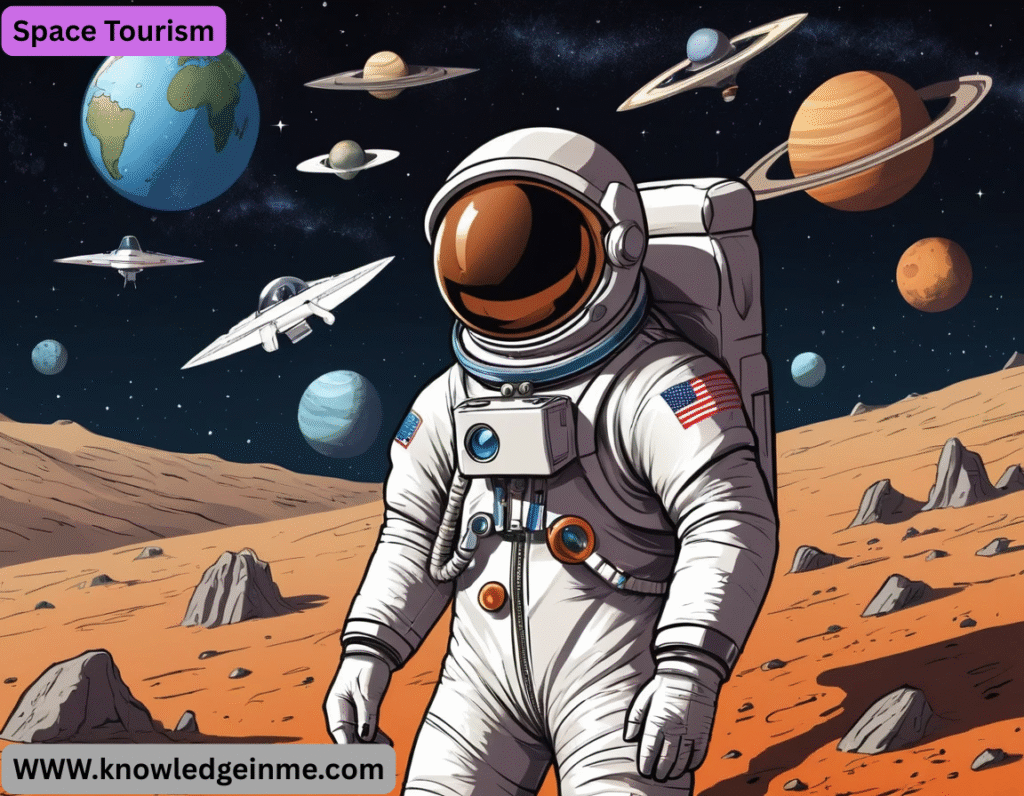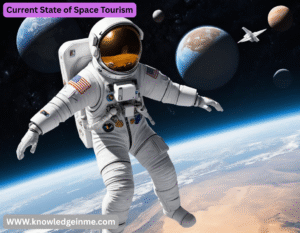Space Tourism Space tourism is an emerging sector that allows private individuals to experience space travel for recreational, leisure, or adventure purposes. With advancements in aerospace technology and the rise of private space companies, what was once a dream reserved for astronauts is now becoming accessible to civilians.
Types of Space Tourism
- Suborbital Space Tourism
- Short trips to the edge of space (~100 km altitude, the Kármán line).
Companies
- Blue Origin (New Shepard)
- Virgin Galactic (SpaceShipTwo)
- Orbital Space Tourism
- Stays can last days or weeks.
Companies & Missions
- SpaceX (Crew Dragon – e.g., Inspiration4, Axiom Space missions)
- ROSCOSMOS (Soyuz spacecraft – past missions with space tourists)
- Lunar & Beyond Tourism (Future)
- Proposed trips around the Moon or even to Mars.
Planned Missions
- SpaceX (Starship – Dear Moon project)
- Space Adventures (Lunar flyby proposals)
- Current Challenges & Costs
Price: - Suborbital: $250,000 – $500,000 (Virgin Galactic, Blue Origin)
- Orbital: $50 million+ (e.g., SpaceX’s private ISS missions)
Safety & Regulations
- Spaceflight carries risks (e.g., rocket failures, re-entry hazards).
Environmental Concerns
- Rocket emissions and space debris are growing concerns.
Current State of Space Tourism
Suborbital Tourism Short Space Flights
- Altitude: ~80–100 km (Kármán line, the edge of space).
- Experience: 3–5 minutes of weightlessness, panoramic views of Earth.
- Duration: ~90-minute flights (10–15 minutes in space).
Key Players
- Blue Origin (New Shepard) – Fully autonomous, reusable rocket.
- Virgin Galactic (SpaceShipTwo) – Air-launched from a carrier plane.
Recent Milestones
- 2021: Jeff Bezos & crew flew on New Shepard.
- 2023: Virgin Galactic began commercial flights.
Orbital Tourism (ISS & Beyond)
- Experience: Days or weeks in space, full microgravity.
Key Players
- SpaceX (Crew Dragon) – First all-civilian mission (Inspiration4, 2021).
- Axiom Space – Organizing private ISS missions (e.g., Ax-1, Ax-2).
Recent Missions
- 2021: Inspiration4 (3-day orbital trip).
- 2022–2023: Axiom missions to ISS (private astronauts).
Future: Lunar & Deep Space Tourism
Planned Missions:
- SpaceX’s Starship (Dear Moon Project) – Circumlunar flight (scheduled late 2020s).
- Space Adventures & ROSCOSMOS– Proposed lunar flyby.
How Much Does It Cost
Type Price Range Example Missions
Suborbital $250K – $500K Virgin Galactic, Blue Origin
Orbital (ISS) $50M – $100M+ SpaceX Crew Dragon (Axiom missions)
Lunar Trip $100M – $200M+ (est.) SpaceX Dear Moon (future)
Prices expected to drop as technology advances.
Challenges & Risks
Safety Concerns
- Rocket Failures: Even small risks are life-threatening (e.g., Virgin Galactic’s 2014 crash).
- Medical Risks: Microgravity affects the body (bone/muscle loss, fluid shifts).
- Regulations: FAA & other agencies are still refining rules for commercial spaceflight.
Environmental Impact
- Carbon Footprint: Rocket launches emit CO₂ & black carbon (worse than airplanes).
- Space Debris: More flights = higher risk of orbital collisions.
Accessibility & Ethics
- Only for the Ultra-Wealthy: Still far from mass-market affordability.
- “Space Colonization” Debate: Should tourism expand before solving Earth’s problems?
The Future: What’s Next
Space Hotels & Stations
- Axiom Station – Commercial successor to ISS (~2025–2030).
Point-to-Point Space Travel
- Earth-to-Earth in 1 Hour: SpaceX’s Starship could enable ultra-fast travel (e.g., NY to Tokyo in 30 mins).
Moon & Mars Tourism
- Lunar Landings (2030s): SpaceX & NASA’s Artemis program may enable private moon trips.
- Mars by 2040? Elon Musk envisions a self-sustaining colony.
Part 1: How to Book a Spaceflight Today
Suborbital Joyrides (5–15 Minutes in Space)
- Available Now:
- Virgin Galactic
- Price: $450,000 (initial tickets), now ~$600,000
- Flight: 90-minute trip, 4 minutes of weightlessness
- Blue Origin (New Shepard)
- Price: ~$1M (auction-based, exact current pricing undisclosed)
- Flight: 11-minute fully automated launch
- Status: Grounded since 2022 (engine failure investigation), expected to resume soon
How to Book
- Directly through company websites (Virgin Galactic accepts deposits)
- Some space travel agencies (e.g., Space VIP) offer bundled experiences
Orbital Vacations Days in Space
- Available for Ultra-High-Net-Worth Individuals:
- Axiom Space (via SpaceX Crew Dragon)
- Price: $55M+ per seat
- Experience: 10-day ISS stay, includes training
- Next mission: Ax-3 (Q1 2025)
- SpaceX “Free-Flyer” Missions (e.g., Inspiration4)
- Price: ~$50M for full private mission (4 seats)
- Experience: 3-day Earth orbit in Crew Dragon
How to Book
- Direct negotiation with SpaceX/Axiom for private missions
- Limited charity auctions (e.g., Inspiration4’s $200M St. Jude fundraiser)
Future Options Pre-Book for 2030s
- SpaceX Dear Moon (Lunar Flyby) – Delayed but still accepting applications
- Orbital Reef Space Station (Blue Origin/Sierra Space) – Future hotel-like stays
- Voyager Station (Space Hotel) – Targeting late 2020s
Part 2: Training & Physical Requirements
Medical Screening
- Suborbital: Basic fitness (similar to rollercoaster health checks)
Orbital
- NASA astronaut-level cardio (treadmill/VO2 max tests)
- Zero-G tolerance (vomit comet training)
- Psychological evaluation
Pre-Flight Training
- Suborbital: ~3 days (safety drills, G-force prep)
- Orbital: ~6 months (ISS systems, emergency procedures)
- Pro Tip: Some companies offer Zero-G experience flights ($9,500 for a parabolic flight) to test your space legs.
Part 3: What to Pack for Space
- NASA’s Allowed Personal Items for ISS Tourists
- 1.5 kg personal items (compact camera, keepsakes)
- Slim-fit clothing (bulky clothes float awkwardly)
- Velcro shoes (to anchor yourself)
Banned Items
- Alcohol (flammable)
- Loose powders (clog air filters)
- Glass (shatter risk)
Part 4: Risks & Realities
Safety Stats
- Suborbital: 1 fatal accident (Virgin Galactic 2014)
- Orbital: 0 tourist fatalities so far, but Soyuz had close calls
Environmental Impact
- 1 Virgin Galactic flight = 60 transatlantic flights’ CO₂
- Solutions: Companies investing in biofuel rockets (e.g., Spin Launch’s kinetic launch)
Legal Fine Print
- Waivers required: You can’t sue if something goes wrong
- No FAA passenger protections yet (unlike airlines)
Part 5: When Will It Be Affordable
Price Drop Predictions:
Year Suborbital Price Orbital Price
2025 $250K $50M
2030 $100K $10M
2040 $50K $1M
Key Factors:
- Reusable rockets (Starship could slash costs 100x)
- Competition (new players like Star
Tier 1: Experience Space Without Leaving Earth
- For: Casual enthusiasts | Budget: $0 – $10K
Spaceflight Simulators & Zero-G
- Zero-G Experience ($9,500): Fly parabolic arcs in a modified 747 (like Tom Cruise in The Mummy).
- NASA’s Astronaut Training VR (Free apps): Try ISS docking simulations.
- Space Camp (Alabama/Hong Kong): $1,500/week – Train like a real astronaut.
Space-Adjacent Travel
- Rocket Launches: Book a Florida Airbnb near Cape Canaveral.
- Space Museums: Smithsonian (DC), Cosmo drome (Sweden).
Tier 2: Pre-Book for Future Flights
- For: Serious savers | Budget: $10K – $250K
Reservation Programs
- Virgin Galactic: $1,000 refundable deposit (waitlist ~2–5 years).
- Space Perspective ($125K): Balloon ride to stratosphere (book for 2025).
Space Lottery & Crowdfunding
- Omaze Sweepstakes: Occasionally offers spaceflight giveaways.
- GoFundMe Space: A real campaign raised $72K for a teacher’s ticket.
Invest to Fly
- Buy Stock: If you own $SPCE (Virgin Galactic) or $RKLB (Rocket Lab), future discounts may happen.
- Space Crypto: Some NFT projects (like Space Chain) raffle flights.
- Tier 3: Train Like an Astronaut
- For: Future flyers | Budget: $250K – $1M
Medical Prep
- Cardio: Marathon training (ISS requires 2.5 hrs/day of exercise).
- G-Force: Ride rollercoasters like King da Ka (5Gs).
Book Your Flight
- 2025–2026 Slots: Virgin Galactic (New Mexico) or Blue Origin (Texas).
- Payment Plans: Some brokers offer financing (e.g., 10% down, 5-year term).
Packing List
- Must-Haves: Skin-tight clothing (baggy = floating nightmare).
- Leave Behind: Perfume (flammable), peanuts (ISS bans allergens).
- Fun Fact: SpaceX lets you customize your Crew Dragon interior (Inspiration4 had a cupola dome).





